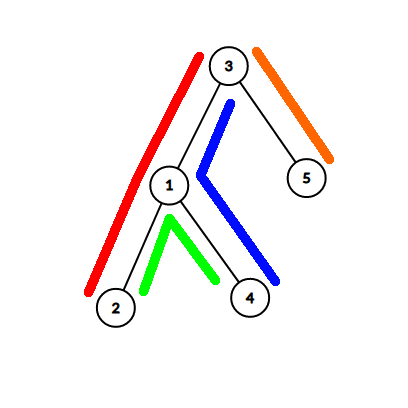| Codeforces Round 703 (Div. 2) |
|---|
| Finished |
You are given a tree consisting of $$$n$$$ vertices, and $$$m$$$ simple vertex paths. Your task is to find how many pairs of those paths intersect at exactly one vertex. More formally you have to find the number of pairs $$$(i, j)$$$ $$$(1 \leq i < j \leq m)$$$ such that $$$path_i$$$ and $$$path_j$$$ have exactly one vertex in common.
First line contains a single integer $$$n$$$ $$$(1 \leq n \leq 3 \cdot 10^5)$$$.
Next $$$n - 1$$$ lines describe the tree. Each line contains two integers $$$u$$$ and $$$v$$$ $$$(1 \leq u, v \leq n)$$$ describing an edge between vertices $$$u$$$ and $$$v$$$.
Next line contains a single integer $$$m$$$ $$$(1 \leq m \leq 3 \cdot 10^5)$$$.
Next $$$m$$$ lines describe paths. Each line describes a path by it's two endpoints $$$u$$$ and $$$v$$$ $$$(1 \leq u, v \leq n)$$$. The given path is all the vertices on the shortest path from $$$u$$$ to $$$v$$$ (including $$$u$$$ and $$$v$$$).
Output a single integer — the number of pairs of paths that intersect at exactly one vertex.
5 1 2 1 3 1 4 3 5 4 2 3 2 4 3 4 3 5
2
1 3 1 1 1 1 1 1
3
5 1 2 1 3 1 4 3 5 6 2 3 2 4 3 4 3 5 1 1 1 2
7

The tree in the first example and paths look like this. Pairs $$$(1,4)$$$ and $$$(3,4)$$$ intersect at one vertex.
In the second example all three paths contain the same single vertex, so all pairs $$$(1, 2)$$$, $$$(1, 3)$$$ and $$$(2, 3)$$$ intersect at one vertex.
The third example is the same as the first example with two additional paths. Pairs $$$(1,4)$$$, $$$(1,5)$$$, $$$(2,5)$$$, $$$(3,4)$$$, $$$(3,5)$$$, $$$(3,6)$$$ and $$$(5,6)$$$ intersect at one vertex.
| Name |
|---|




